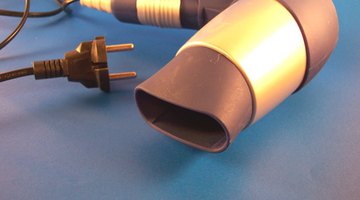Troubleshooting a GE Front Loader Dryer

As with any appliance, issues may crop up now and then with GE front-load dryers. Most homeowners can troubleshoot operational issues with their GE front-loader themselves. If basic troubleshooting doesn’t resolve the issue, or the problem is related to electrical issues or damaged parts, it’s time to contact a technician for service.
No Power
If your dryer won’t turn on, check the circuit breaker or fuse panel and make sure it is running on a 30-amp dual breaker or two 30-amp fuses. GE recommends that your dryer be connected to its own 220 volt outlet as well. Reset tripped breakers or replace blown fuses, and if this doesn’t correct the problem, unplug your dryer and inspect the power cord. If the cord is damaged, contact a certified technician to repair it.
Drum Doesn't Turn
If the dryer is overloaded or contains a load of heavy or wet clothes, such as towels or jeans, the drum may not turn. Remove some of the clothes and start the dryer again. If the drum still doesn’t turn, unplug the dryer and try to turn it manually. If it turns freely, the belt may be broken or loose. If this is the problem, you’ll typically hear a loud thump as you turn the drum. Contact a certified technician to repair the belt.
Stops Mid-Cycle
If the door switch is burned or pushed in, or if the start button isn’t pushed in all the way, your dryer may stop mid-cycle. Make sure the front of the dryer isn’t blocked as well, because items in front of the dryer may block air flow, causing the dryer to overheat and automatically turn off. If your dryer has an automatic no-load detection system, and the display screen reads "Clean Lint Filter," verify that the dryer is level. Dryers that tilt backward may have trouble sensing when a load is present, because the clothes move to the back of the drum and away from the sensor rods.
No Heat or Long Drying Times
Long drying times can occur if you’re trying to dry too many items, or if the items in the dryer are overly wet, or if the dryer isn’t level. If these aren’t the cause, unplug the dryer and clean the lint filter, and then check the breaker or fuse panel. If one of the breakers trip or one of the fuses blows, it’s possible that the dryer may tumble the clothes, but won’t produce heat to dry them. Reset the breaker or replace the fuse, and if this doesn’t correct the problem, confirm that the dryer is fully plugged into a 220-volt outlet. If troubleshooting doesn’t resolve the problem, contact a certified technician to inspect the dryer.
Noisy Operation
According to GE, it’s normal for your front-load dryer to squeak for a few seconds during start-up. GE gas dryers may buzz as the solenoid valve opens, and this is normal as well. If your dryer is thumping or scraping, inspect to see that it is level and that there’s nothing leaning against it on all sides. Unplug the dryer if troubleshooting doesn’t identify or correct the noise. Remove the lint filter and shine a flashlight into the opening. Remove any foreign objects visible inside the lint filter opening. Inspect the drum as well. Objects stuck in the front seal or worn drum slides can cause a scraping sound. If your dryer is making any unusual noises you haven’t heard before, or troubleshooting doesn’t identify odd sounds, contact a technician for service and don’t use the dryer until it is repaired.
References
- GE Appliances: Dryers - My Dryer or Timer Stops During the Cycle
- GE Appliances: Dryers: Taking Too Long to Dry Clothes
- GE Appliances: Dryers - Electric Dryer Has No Power
- GE Appliances: Dryers: Dryer No Heat
- GE Appliances: Dryers: The Dryer Drum Does Not Turn
- GE Appliances: Dryers: Will Not Run or Start
- GE Appliances: Dryers: Noises
Writer Bio
Renee Miller began writing professionally in 2008, contributing to websites and the "Community Press" newspaper. She is co-founder of On Fiction Writing, a website for writers. Miller holds a diploma in social services from Clarke College in Belleville, Ontario.
Photo Credits
- dryers image by timur1970 from Fotolia.com
- dryers image by timur1970 from Fotolia.com
More Articles



